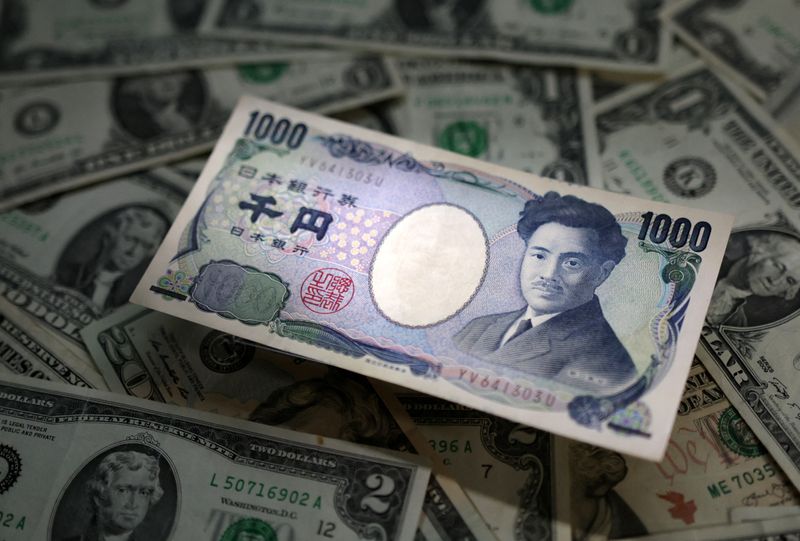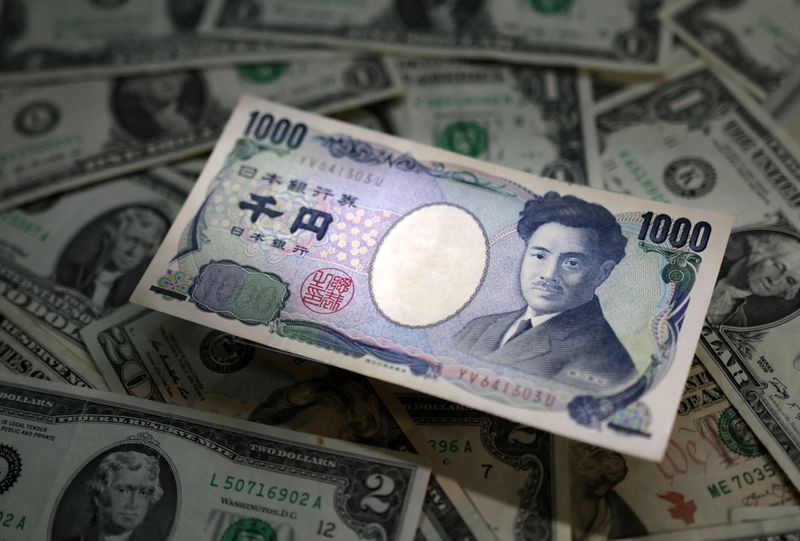Forex
Instant view: Japanese yen surges, ringing intervention alarm bells

(Reuters) – The Japanese yen surged nearly 3% on Thursday in its biggest daily rise since late 2022, a move that local media attributed to a round of official buying to prop up a currency that has languished at 38-year lows.
The dollar dropped to as low as 157.40, straight after data showed U.S.consumer inflation cooled more than expected in June.
Yet the scale and speed of the move put traders on alert to the possibility of Japanese intervention. Authorities stepped in as recently as early May to bolster the yen.
Domestic news service Jiji cited top currency diplomat Masato Kanda as saying he could not comment on whether or not there was an intervention, but that recent moves in the yen were “not in line with fundamentals”.
COMMENTS:
MICHAEL BOUTROS, CHIEF TECHNICAL STRATEGIST, FOREX.COM, NEW YORK
“I find it hard to believe there was someone sitting there waiting for that, to throw fuel on the fire. It would be a really strategic move, but I just don’t think that’s how they operate. More so than the nominal level… their assertion has always been the speed of the move. So there was nothing here today, this week, that would suggest something would spark this move all of a sudden for them to jump in.”
“I’m treating this right now as proper market mechanics. It’s been a strong uptrend. We need these pullbacks. These pullbacks are healthy within uptrends. Even on basic technical standards you’re seeing divergence on the weekly chart in momentum, we’ve been tracking this on the daily chart as well, so its been looking for catalysts in my opinion, and all we needed was that weak print… not only is price action correcting lower because of dollar weakness, but also we’re repricing the interest rate divergence lending to that carry trade unwind as well, and we’ll see if that unwind leads to a larger trend reversal.”
GARRETT MELSON, PORTFOLIO STRATEGIST, NATIXIS, BOSTON
“Just looking at the charts and listening to some of the chatter – seems pretty likely the MOF did intervene this morning after the CPI print. Vice Finance Minister Kanda with a typical refusal to answer to whether or not there was intervention, but the first leg down for the JPY was right at the CPI print after which it stabilized before the next larger leg lower about 10 minutes later.”
“Again, very possible the fundamentals are a key driver here given extended positioning, but looking closer at the timing of the moves with the MOF’s no-comment seems like an admission of some action taking place.”
PAULA COMINGS, HEAD OF FX SALES, U.S. BANK, NEW YORK
“The focus in the coming days will be how today’s movement impacts overall volatility for corporates that are hedging both long JPY revenues and short JPY expenses.
“We sailed through the technical level we were watching at 158.26, which we hit on June 20. The next level down would be 155.70, which was the low on June 12.
“This is a strange time in the market where an argument can be made that there are opportunities to enter into options-based strategies at favorable rates and/or prices to either buy or sell JPY.”
ATHANASIOS VAMVAKIDIS, GLOBAL HEAD G10 FX STRATEGY, BOFA GLOBAL RESEARCH, LONDON
“I think it was just the reaction to the weak US CPI and the squeeze of the market long USD positioning. The USD weakened across the board, but more so against the JPY because of positioning.”
CHRIS SCICLUNA, HEAD OF ECONOMIC RESEARCH AT DAIWA CAPITAL MARKETS, LONDON
“The MOF won’t confirm this for some time but the extent of the move gives a strong impression that it has been active and taken advantage of the post U.S. CPI data to take action.”
HELEN GIVEN, FX TRADER, MONEX USA, WASHINGTON DC
“Traders have speculated for the last couple of months that any potential intervention from Japanese currency officials may be financed by the sale of their US treasury holdings, so any substantial move lower there is going to impact JPY more than other G10 currencies.
“We’ll have to see, of course, whether today’s big move for JPY holds up over the next week or so, but this is definitely good news for BoJ as speculation on if and when they may intervene on behalf of the flailing currency has plagued markets consistently for the last month.”
SAMEER SAMANA, SENIOR GLOBAL MARKETS STRATEGIST, WELLS FARGO INVESTMENT INSTITUTE, CHARLOTTE, NORTH CAROLINA
“With CPI doing what it’s doing, it’s hard to kind of disentangle the two. Given the fact that the biggest portion of the move happened around the time that CPI was released, I would say it’s more CPI than intervention. It is possible they did something overnight.”
GEOFF YU, SENIOR MACRO STRATEGIST, BNY MELLON, LONDON:
“Our view is that rate differentials are clearly converging as a September (U.S.) rate cut is priced in.”
“Hard data also shows yen shorts are the strongest in almost three years and quite extreme so there’s no resistance to the upside.”
MARC CHANDLER, CHIEF MARKET STRATEGIST, BANNOCKBURN GLOBAL FOREX, NEW YORK
“I’d be surprised if they are, partly because of the time zone and partly because the dollar is responding to fundamentals as we would expect – softer CPI, lower U.S. rates, and of course dollar/yen falls… I think the market got caught leading the wrong way.”
“I think there’s three broad conditions. Volatility, and volatility is not very high, it wasn’t going into today. Secondly, I think they care about a one-way market, and it hasn’t been really a one-way market for a couple of weeks. And thirdly, I think about how the dollar reacts to fundamentals, and this is responding in line with fundamentals. So, the three broad criteria I don’t think are met.”
GIUSEPPE SERSALE, PORTFOLIO MANAGER, ANTHILIA, MILAN
“The yen is currently making fireworks. Honestly, I couldn’t say exactly what’s driving it. If the movement persists, it could mean that short-term positioning was too skewed towards short yen. And this US data created a situation where there was a violent rebound and a series of stop losses for those short on yen.”
“If, however, the movement deflates, halves during the day, or becomes very erratic, it means there was also a contribution from the Japanese Treasury, who at this moment doesn’t admit it… the move however seems excessive since the euro is gaining half a point, the pound is gaining half a point, and so on. Therefore, I have the impression that there is also a bit of contribution from the Japanese.”
JAMES MALCOLM, HEAD OF FX STRATEGY, UBS LONDON:
“My personal guess is that this is not intervention.”
“The thing is the market position is so, so extended that it can feed on itself very, very easily, Regardless of whether you think it should be stabilising, if dollar-yen is dropping and you’re long, you have to get out… that’s the definition of a classic carry unwind.”
“There is an incentive to perhaps to do a little bit of intervention later in the day to ensure it doesn’t rebound.”
KENNETH BROUX, HEAD OF CORPORATE RESEARCH FX AND RATES, SOCIETE GENERALE
“It’s certainly a big move but I don’t think we can say it’s anything to do with intervention,” said Societe Generale (OTC:)’s head of corporate research FX and rates Kenneth Broux.
“The US CPI has been a trigger and it’s more about stops being triggered than intervention,” he said.
STEVE ENGLANDER, HEAD, GLOBAL G10 FX RESEARCH AND NORTH AMERICA MACRO STRATEGY, STANDARD CHARTERED BANK NY BRANCH, NEW YORK
“Obviously the yen story has been a rate differential story and positions – long dollar/yen positions – have piled up. So when you get a number that’s this definitive in terms of making, say, September highly probable and kind of reinstating the disinflation story, that rate differential story erodes. Most likely it was cleaning up of positions because my sense from clients, especially short-term traders, is that everybody had some long dollar/yen on that they were thinking that maybe 165 or higher was kind of where it was headed.”
“There’s some vague speculation on intervention, just everybody’s looking at the price chart and kind of saying, oh, that’s, kind of a sharp drop so maybe could have it been. The answer is it could have, but I’d say most likely its position squaring rather than any official moves.”
LEE HARDMAN, SENIOR FX STRATEGIST, MUFG, LONDON
When the market is heavily positioned in one direction and then it goes the other way it can trigger this kind of abrupt move. Dollar/yen long positioning was very stretched
COLIN ASHER, SENIOR ECONOMIST, MIZUHO, LONDON
“Most likely, it’s just short covering, as speculation of US rate cuts on the horizon build in the wake of the negative CPI print.”

” is the G10 pair where positioning is most stretched.”
“It’s certainly a sizable move, with the intra-day range the biggest since the intervention at the start of May.”

 Forex3 years ago
Forex3 years agoForex Today: the dollar is gaining strength amid gloomy sentiment at the start of the Fed’s week

 Forex3 years ago
Forex3 years agoUnbiased review of Pocket Option broker

 Forex3 years ago
Forex3 years agoDollar to pound sterling exchange rate today: Pound plummeted to its lowest since 1985

 Forex3 years ago
Forex3 years agoHow is the Australian dollar doing today?

 Cryptocurrency3 years ago
Cryptocurrency3 years agoWhat happened in the crypto market – current events today

 World3 years ago
World3 years agoWhy are modern video games an art form?

 Commodities3 years ago
Commodities3 years agoCopper continues to fall in price on expectations of lower demand in China

 Economy3 years ago
Economy3 years agoCrude oil tankers double in price due to EU anti-Russian sanctions


























